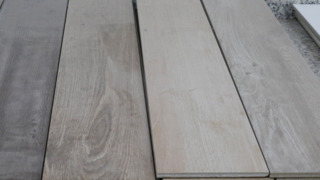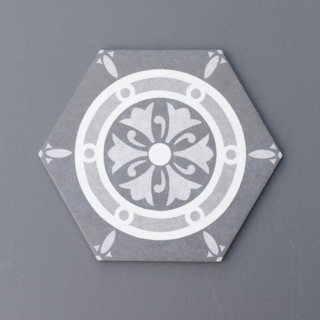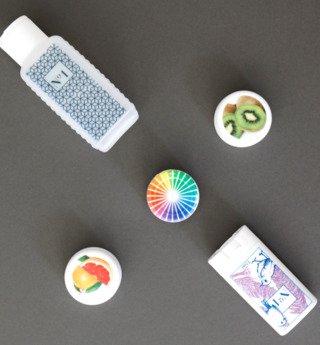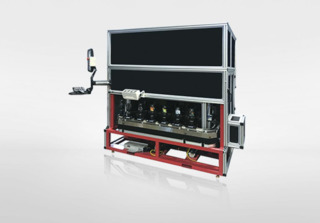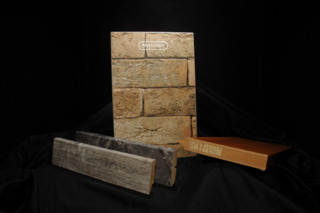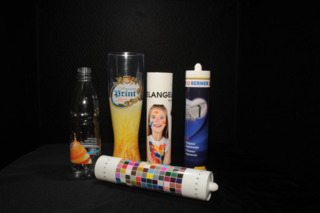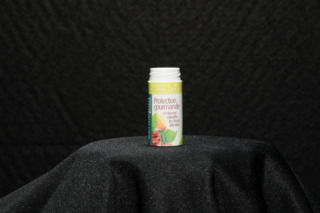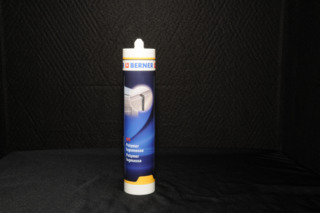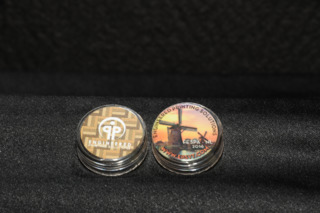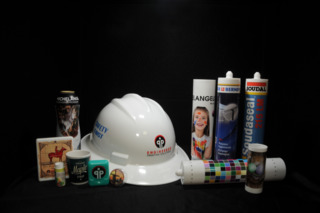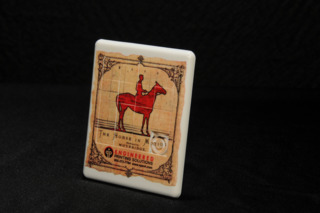Surface Tension: Specialty Substrates Are Proliferating, but Printing on Them Has Its Challenges
An inkjet printing reality check
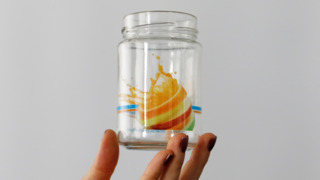
One word: plastics. And Glass. Ceramics. Wood. Decking material. Three-dimensional objects. Dentures—now there’s a print application you can really sink your teeth into (or vice versa).
“I’ve printed on everything from golf balls, to toothbrushes and dentures to spray cans and garage door panels that from a distance look like a beautiful mahogany,” said Mary Schilling, technical inkjet consultant and head of print quality analysis for Inkjet Insight.
Inkjet. Is there anything it can’t print on?
Well, that will depend on what you mean by “print” and your quality expectations. After all, you could run a sheet of Reynolds Wrap through a desktop inkjet printer and it will “print” on it. Whether that print would be something you could use or sell is another thing entirely.
We’ve all heard and read about how inkjet printing has evolved to the point that virtually any material, any surface, even any object can conceivably be a printing substrate. While this is true, and while there are business opportunities to be had in printing on unusual materials, the fact is that getting print to work on unique substrates as you expect it to—or, more crucially, as your customer expects it to—takes no small amount of education, trial and error, and maybe even good old-fashioned luck. After all, inkjet printing—indeed, all printing—involves chemical and physical relationships between two disparate materials, the ink and the surface. And while inkjet ink has come a long way, the idea of a single ink that will adhere perfectly to every conceivable surface is probably the chemical equivalent of a perpetual motion machine. It just ain’t gonna happen.
“It really depends on what the customer’s requirements are, because the ink and the substrate compatibility has to be so fine-tuned,” Schilling said. “If you can’t fine-tune it, then you have to use a pretreatment like corona, plasma or flame.”
It will also depend on what specifically you are trying to print—simple text and logos, for example, vs. solids, images or precise colors. We say “ink” but we’re really talking about at least four inks.
“Cyan, magenta, yellow and black aren’t going to be equally compatible with a surface treatment or with the surface tension of the substrate,” Schilling said. “You may have magenta and yellow give you problems, but black and cyan don’t.”
And if we add additional or extended gamut colors, the problem could gets worse.
Liquid Mettle
Let’s back up a second and review a few basics about ink. Most ink consists of two elements: a colorant, the dye or pigment that supplies the color, and a vehicle, the liquid that, as the term suggests, conveys the colorant to the substrate, where it then needs to adhere. As we know from ink-on-paper printing, ink adhesion works through a combination of absorption of the colorant and a portion of the vehicle into the substrate, and evaporation of the vehicle. Uncoated papers more readily absorb ink than coated papers because it is easier for the fluid to soak into the sheet. Most of the time, you don’t want too much to be absorbed or “wick” into the paper or you’ll get muddy halftones and muted colors. As a result, high-quality printing depends on an optimal amount of ink holdout, or staying on the surface of the sheet.
Meanwhile, you usually need to evaporate the vehicle rapidly, especially if the print will be duplexed, finished or needs to be delivered very quickly. How this is accomplished is usually what distinguishes one type of ink from another.
Juggling absorption and evaporation of the various components of an ink has been one of the biggest tricks in the production inkjet space, and has involved ever-evolving ink formulations, paper pre- and post-treatments, faster dryers and all sorts of other physical and chemical means.
Dyne-ing Room
Inkjet printing on paper has been a tough enough nut to crack. Now we have all the gazillion other surfaces we can print on, which just magnifies the perennial issue of ink adhesion.
Unlike production inkjet—or most ink-on-paper printing—the inks that have led to the substrate revolution are UV inks. That is, they dry (or cure) through exposure to ultraviolet light. UV inks are not a new technology, and have been used in web offset printing for decades. Exposure to ultraviolet light—either via traditional mercury vapor or newer, cooler LED lamps—quickly polymerizes the ink, turning it into a thin plastic film that sticks readily to virtually any surface.
“Virtually” any surface. Let’s qualify that.
The extent to which an ink will adhere to a surface is a function of the respective dyne levels of both the surface to be printed and the ink.
A substrate has a certain amount of surface energy, or the extent to which the molecules on the surface of a material have more energy compared to the molecules deeper in the interior of the material. This is called its "dyne level." (For those playing along at home, one dyne is the amount of force required to produce an acceleration of 1 centimeter/second2 on a mass of 1 gram.)
A liquid, like an ink, has a corresponding property called "surface tension," which is also measured in dynes and is referred to as its dyne level.
The relationship between a substrate’s dyne level (aka surface energy) and an ink’s dyne level (aka surface tension) determines how well that ink will adhere to that surface. If the surface’s dyne level is higher than that of the ink, then the ink will spread out over the surface in a uniform layer, “wetting” the surface and adhering properly. If the surface’s dyne level is equal to or lower than that of the ink, the ink will bead up on the surface of the substrate or otherwise not adhere properly.
Think of your car. An unwaxed car has a high surface energy compared to water, so when it rains, the drops will spread out, form puddles, penetrate into your paint job and cause problems. But if you apply a coat of wax to your car, it lowers the dyne level of the car’s surface relative to that of the water, so that when it rains, the drops will simply bead up and roll off.
The same basic principle applies to inks and substrates. Plastic, glass and other non-paper materials have non-porous surfaces with low surface energy, and thus require lower-dyne-level inks, or some kind of surface treatment that will boost the dyne level of the substrate, kind of like Turtle Wax for printing.
The question is, how do you measure these dyne levels? The easiest way is with what is called a “dyne pen,” which applies a thin film of a fluid having a known and standard dyne level. If the film laid down beads up, you know the dyne level of the surface is lower than that of the fluid, so that tells you what the dyne level range of the ink you ultimately want to use will be. In the most general sense, it will also give you an idea of any ink-surface incompatibility.
The Trick to Treating
So what do you do if your respective dyne levels are out of whack? There are two options: pick a new ink or treat the surface in some way. Essentially, you are breaking down and transforming the molecular bonds in the surface. There are a few basic ways of accomplishing this.
- Flame Treatment—You apply intense heat using a gas flame to break the molecular bonds in the surface. Flame treatment is fast (faster than corona treatment, e.g.), but can have environmental and safety considerations if used in-line with manufacturing.
- Corona Treatment—Essentially, you have a surface struck by lightning—after a fashion. You expose the surface to an electrical or corona discharge. This breaks the molecular bonds in the surface, producing free radicals that then undergo further chemical reactions, the end result being a surface that is more receptive to ink. There are companies that sell corona treatment systems.
- Plasma Treatment—No, you don’t bleed on the substrate (the blood probably wouldn’t stick anyway). Plasma is one of the four basic states of matter, comprising ionized gas. A plasma treatment zaps the substrate with this ionized gas, which causes oxidation of the surface and, again, transforms its surface properties such that it is more accepting of ink. There are companies that manufacture plasma treatment systems—and many companies specialize in both corona and plasma treatment equipment.
- Pre-treatment—A fourth alternative is to treat the surface with a chemical prior to printing that helps the ink bond. Some production inkjet systems and even textile printing systems use a surface pretreatment to help with ink adhesion.
Which type of treatment to choose will largely be a function of the kind of surface you are trying to print on.
A Tale of Two Cities
What we have been talking about falls into the category of “industrial printing.” The machines and applications we typically write about fall into the more commercial printing category. Over the past 20 years, UV flatbed machines from the likes of Agfa, Canon Solutions America, Durst, EFI, Fujifilm, Mimaki, Mutoh, Ricoh, Roland, swissQPrint and others have demonstrated that they can print on a wide variety of substrates. Have they solved the puzzle of the ink adhesion issue?
“The market expects wide-format suppliers or PSPs to be willing to print on maybe not anything, but close to anything. I think now that we’re 20 years into it, a lot of manufacturers have had considerable time to develop inks that allow for that,” said Dan Johansen, marketing manager, wide format solutions, for Ricoh.
Ricoh’s most recent UV flatbed introduction is the Ricoh Pro TF6250.
“Now it’s a combination of both inks and the substrates themselves. We’ve been going through a bit of a renaissance the last 10 years where manufacturers have enhanced or improved their inksets, some of whom also have developed more than one inkset to offer customers a choice if they’re printing on more challenging substrates,” Johansen said.
That’s an important “if” because despite the growing interest in specialty—or downright wacky—substrates and surfaces, a mass market isn’t necessarily there just yet.
“Right now, for most PSPs doing wide format, it’s not very often that a print buyer asks for a job to be produced on something where the substrate required isn’t readily available," Johansen said. "So it’s a combination of a majority of devices with inks good enough for most substrates combined with substrates that may close that gap a little further.
“I think we’re exponentially closer to sort of a ‘one ink to rule them all.' It wouldn’t necessarily be one ink, but I think those of us that have been developing technologies for wide-format, specifically wide-format UV LED, are about as close as we’ve ever been to that sort of Swiss Army knife approach.”
One other sticking point—as it were—is color gamut and color consistency.
“We invested a lot of time, effort and money when we developed our new flatbeds to develop an inkset that had the best mix of substrate adhesion and color gamut,” Johansen said. “Historically, where we had one, it was at the sacrifice of the other. If you wanted tremendous adhesion, it tended to come on the expense of overall color gamut, and the best color gamut may not offer the greatest adhesion.”
For those substrates that do pose a challenge, flatbed wide-format equipment manufacturers offer pre-treatment options.
“Companies like Ricoh, for example, offer a solution with our flatbed devices that does allow for a primer to be laid down,” Johansen said. “They can choose a [flatbed printer] configuration that includes a primer to allow the device to precoat the substrate before inking.”
Surface Stations
So what is it exactly that people are trying to print on? After all, before we go to the effort of figuring out how to print on something, we should see if it’s something that the market is demanding.
Direct-to-object printing, particularly drinkware, has become a large and growing market sector.
“The market at this point is heavily focused on drinkware and custom decoration,” said Ken Tyler, sales engineer for Engineered Printing Solutions.“It has become a dominant request for most of the sales people throughout our territory, which is worldwide.”
To handle those requests, EPS launched a product called the XD-360 Cylindrical Inkjet Printer.
“That machine was focused on putting custom inkjet decoration on drinkware at a high rate of speed,” Tyler said. “That specific market is very under-supplied on digital capacity. There are a lot of old analog systems that produce the McDonald’s and stadium cups at extremely high rates of speed, but those machines have some limitations as you need to have very long runs.”
As in virtually every other printing industry segment, demand for shorter and more customized runs is increasing here as well. Tyler said this is suitable for “the small mom and pop shops that are just looking to get a hundred cups made for a wedding that might have some personalization on it.”
There has been a lot of increasing demand for printed materials that resemble other kinds of materials, specifically wood. Printed plastics have certain advantages over wood for décor applications.
“You’ve got the composite board that they’re putting together for decking,” Schilling said. “It’s a custom-printed PVC plastic board that you can get for your deck. It’s going to last a lot longer than wood, but it’s going to look like redwood, walnut, oak and you can pick your color. You can also do custom designs. You could put a big Colts logo on your deck.” (Schilling is based In Indianapolis.)
Tyler has also seen these kinds of applications grow.
“An area that has been big has been faux wood grains,” he said. “Window shades, flooring, siding on a building—a lot of that is coming in as a raw material, just white, PVC plastic or a metal-like aluminum siding, and it’s getting the wood grain printed on it. So you end up with a final material that ends up looking like wood. You’re getting what appears to be a high-end product at a low production cost because they don’t have to use real wood.”
Plastic is also lighter weight than wood, which is also perfect for some décor applications, such as the interiors of RVs.
“The edge molding, crown molding, door molding—they’re not using wood for that,” Schilling said. “They’re using a very light plastic like a poly and then they're printing the woodgrain on it because it makes the RV a lot lighter.”
Digitally printed ceramic tile is also a growing area.
“When you go to a tile store, take a loupe with you,” Schilling added. “I do that all the time.”
And you might also want to take a loupe with you the next time you look at a house whose MLS listing boasts “wood floors.”
Objets d’Inkjet
If you have been to an SGIA or PRINT show in recent years, you have seen the small UV desktop or benchtop machines from the likes of Roland, Mimaki and others that are designed to print on 3D objects like golf balls, smartphone cases and even some cylindrical objects like water bottles, YETI cups, etc. The challenges to this kind of specialty object printing are mitigated somewhat because they are not printing these items on an industrial scale, but there is some degree of surface treatment required—even if it’s just making sure the surface is clean.
“Everything has to have some kind of preparation because nothing comes in perfect,” Schilling said. “You still have to wipe them down. If there’s dust on a piece of material, the UV ink isn't going to stick because the dust isn't sticking. If you want your fingerprint to go worldwide, touch something and then print it in UV ink, because your fingerprint will be perfect.”
There could be a crime show here. CSI: SGIA.
Do Your Homework
Inkjet printing is advancing by leaps and bounds, but anyone looking to get involved in specialty printing really needs to do their homework.
“Everybody just keeps saying, ‘It’s so easy, it’s so easy,’ and it’s not,” Schilling said. “There are all these things you still need to consider.”
This is not to dissuade anyone from pursuing unique applications, but they should go in knowing that these challenges exist and to be prepared for them. Fortunately, equipment vendors and manufacturers—and consultants like Schilling—are there to help.

